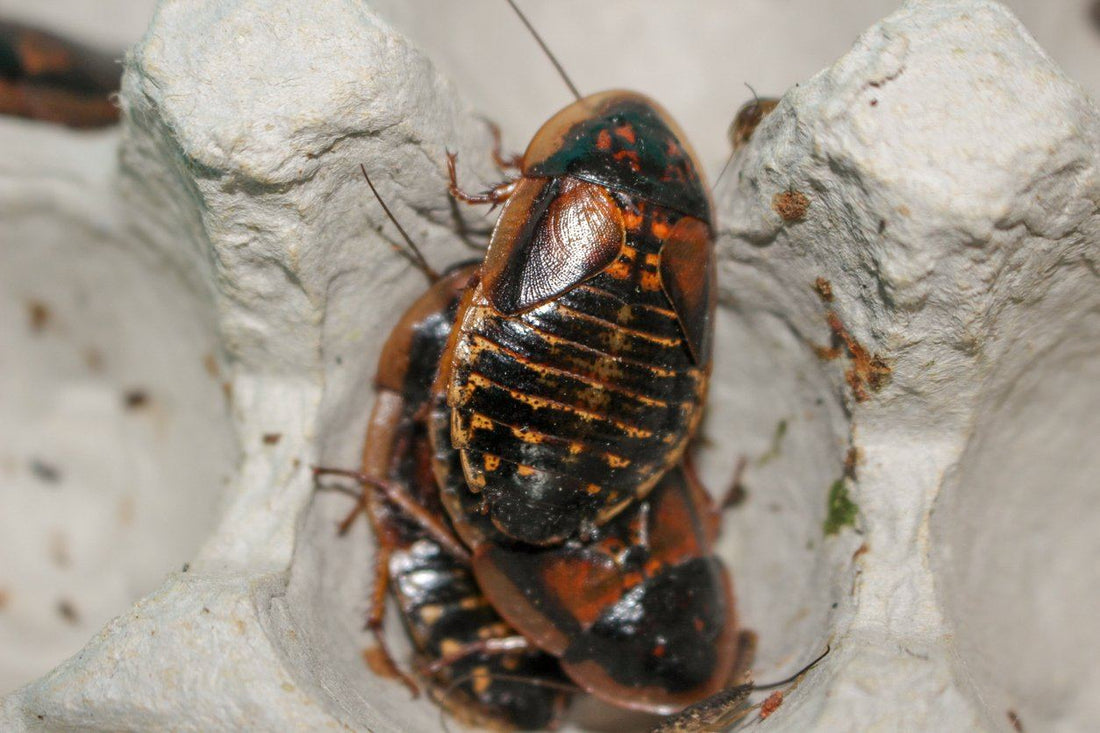What are Dubia Roaches?
Dubia roaches (Blaptica dubia) are also known as orange-spotted roaches, the Guyana spotted roach, and the Argentinian wood roach. These are a medium-sized type of cockroach native to Central and South America.
Dubias are one of the most popular live feeders for omnivorous and insectivorous reptiles, amphibians, invertebrates, and other exotic pets. Many argue that dubia roaches are one of the best feeder insects to have in your rotation. They are nutritionally well-rounded, easy to digest, easy to keep, have a low risk of parasites, and come in a variety of sizes to suit a variety of pets.
Supplies You Will Need for Dubias
- Aquarium (at least 10 gallon) or plastic tub (at least 40 qt)
- Enclosure cover (vinyl mesh and hot glue gun needed if converting a plastic tub cover)
- Ceramic heat emitter, UTH or heat cable
- Thermostat or lamp dimmer if a UTH or heat cable is used
- Egg crate flats
- Water crystals
- Roach food
- Shallow bowls
- Extra enclosure to use when cleaning
How to House Your Dubia Roaches
First you will need a smooth-walled enclosure — at least 10 gallons or 40 quarts. Although dubia roaches aren't particularly good climbers compared to other roaches, they can still climb rough surfaces. So when choosing a container for your dubias, look for something with smooth sides so they can't potentially climb out. Glass aquariums work very well, but you can also use a ventilated plastic tub.
The enclosure should also be covered to further prevent escape and retain heat and humidity — mesh terrarium covers work well for aquariums, but if you're using a plastic tub lid, make sure to drill some holes in it for air flow. You can also cut a large hole in the cover and hot-glue fine mesh over the opening.
Fill the enclosure with cardboard egg flats. This gives the dubias somewhere to climb and hide while maximizing the available space in the enclosure. For best results, stack the flats vertically so the roach droppings (frass) fall to the bottom of the enclosure for better hygiene. The egg flats should not be tall enough to potentially allow the roaches to escape from their enclosure.
Substrate is not necessary.
Heat and Humidity Requirements for Dubia Roaches
Although dubia roaches can survive at room temperature, they do best at 90-95°F and 60% humidity.
Most people use a ceramic heat emitter (CHE) or under-tank heater (UTH) to achieve these temperatures. CHEs should be installed on top of the enclosure to radiate heat downward — these are generally not a good idea with plastic tubs. UTHs should be installed on the side of the enclosure. Both devices need to be plugged into a thermostat to make sure they don't overheat and accidentally cook your dubias.
The correct humidity levels are usually achieved naturally from the dubia's food and water sources evaporating in the heat.If you want to check them, install a digital probe thermometer/hygrometer device in the enclosure.
How to Feed and Hydrate Your Dubia Roaches
What you feed to your dubia roaches is eventually what you feed to your pet, so it's important to make sure that your feeders get high-quality nutrition.
You can use products like Roach Chow to keep your dubias fed and watered. Using a commercial chow rather than trying to make your own formula is a good way to make sure they're getting the nutrients that they need. You can also throw in some fresh Organic vegetables like dark leafy greens, sweet potato, or squash to give them some extra vitamins and hydration. Be sure to thoroughly wash all Organic produce before offering it to your Dubia. Avoid high-protein foods like dog food, cat food, or fish food, because dubia roaches convert excess protein into uric acid, which can be harmful to reptiles.
It's best to use polymer-based water crystals like Dubia Dew to hydrate your roaches. Never give a water dish to dubia roaches, as they may drown in it. Alternatively, if you are using a powdered roach diet, you can mix the powder with water to form a paste that will both feed and hydrate your dubias.
Make sure to remove moldy food from your colony promptly — mold is lethal to roach colonies!
How to Clean Your Dubia Roach Enclosure
Dubia roach frass (droppings) will gradually build up on the bottom of your enclosure, as well as other waste like dried-up vegetable pieces and shed exoskeletons. Clean and disinfect your dubia roach enclosure once every 1-2 weeks to reduce parasites.
The best way to do this is to have a spare enclosure on hand. Transfer the egg flats and all roaches to the extra container, then sift the frass on the bottom to catch hiding roaches and transfer them to the new enclosure as well.
Egg flats should be replaced when they become excessively chewed up, stained, or start to degrade.
Once the roaches are out, if possible take the enclosure outdoors for cleaning so you have good ventilation. Empty the frass from the original container into the garbage or compost pile. Then give it a thorough rinse and disinfect with an animal-safe disinfectant like chlorhexidine or F-10SC, using as per the directions on the label. Let dry. This enclosure will be your "spare" for the next cleanout.
Important Note
Some people develop an allergy to dubia roaches and frass due to too much handling or constant contact. This is more likely to occur if you are breeding roaches rather than simply keeping them, especially on a larger scale. The best way to avoid developing an allergy to dubia roaches is to handle them in a well-ventilated room and wear gloves, if possible.
Want to know more about Dubia roaches? Check out this Wikipedia article: https://en.wikipedia.org/wiki/Blaptica_dubia











